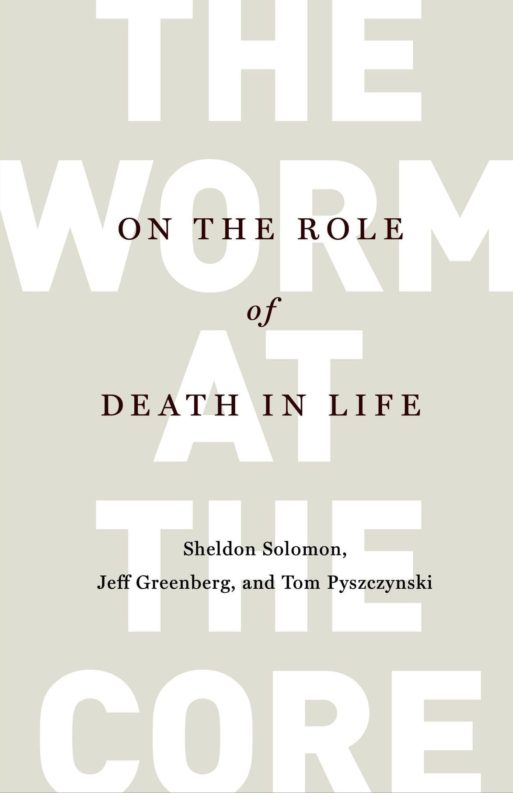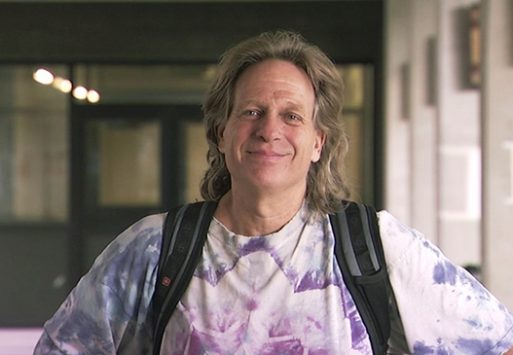
Credit: Rakuten Kobo Inc.
“The Worm at the Core: On the Role of Death in Life,” coauthored by Sheldon Solomon, Jeff Greenberg and Tom Pyszczynski, is a book for now. As we enter November, the United States is falling off the precipice of the COVID-19 pandemic’s fall surge. We’re in the throes of a presidential election that had life-and-death stakes even before the pandemic. Protests against racial injustice continue. Everything is gnawing — differently for all of us, but still gnawing.
Solomon, Greenberg and Pyszczynski argue that everything in human behavior — from the 1969 moon landing to the cave paintings at Lascaux to my indulging in Korean barbecue for lunch — is shaped in small or large ways by a gnawing terror about our eventual, inescapable death. We know we’re going to die. Individually and as a species, we put tremendous effort into not dying, but we put just as much effort into not thinking about it.
In this way, we as humans are too smart for our own good. We have big, high-powered brains that let us talk about intangible ideas, invent tools to solve problems and draw lines from the past into the future. We’re self-aware. We can look in the mirror and know it’s us and not someone else. But the same brain power that makes us aware we’re us and the mirror is just a reflection makes us smart enough to figure out we’re going to die someday.
This awareness of death is the downside of human intellect … We pay a heavy price for being self-conscious.
Our brains also let us make music, grow our own food, fall in love, build cities. We don’t get to have these incredible abilities to invent and experience without also realizing death is coming. In the mirror, we see our skin wrinkle and our hair turn gray, and we can’t deny what’s happening to us. It’s like “a cosmic joke,” the coauthors say.
But we try hard to deny it. “The Worm at the Core” gathers three decades of research by Solomon, Greenberg, Pyszczynski and their colleagues as they explore our psychological defenses against the paralyzing terror of death. The data collected from their experiments reveals just how present death is in the back of our minds all the time — and the tremendous effort we put into keeping it there.
To some degree, we have to keep thoughts of death far from our consciousness, or else we’d be paralyzed by terror like deer in the headlights. We’d be unable to eat, sleep, go to work, raise our children or have sex to make those children. Our terror is an evolutionary fight-or-flight response. But for most (though not all) of us, there’s usually no actual daily threat of imminent death (at least when there’s not a global pandemic). But our brains still want to fight or flee, and so our responses to death manifest in complex ways in our personal behavior, interpersonal relationships, and society and culture.

As our ancestors evolved, they learned to walk upright, as seen in this replica of ancient hominid footprints. They also grew more intelligent, developing both self-awareness and a terror of death.
Credit: Momotarou2012 on Wikimedia Commons
The experiments in “The Worm at the Core” can be as simple as they are revealing. In one of the first experiments described in the book, a group of judges in Arizona completed a short questionnaire about their thoughts and emotions about their own deaths prior to reviewing the case of a (fictitious) woman arrested on a prostitution charge. A control group of judges who didn’t complete the questionnaire set bond for the same made-up woman at about $50. The judges who wrote about death set an average bond of $455. Writing about their own deaths for a short period of time before reviewing the case led to them lashing out at someone whose behavior they perceived as criminal and perhaps immoral.
Solomon, Greenberg and Pyszczynski use their decades of evidence to build a case that all our judgments and behaviors are affected by our fear of death, whether we realize it or not. This manifests in everything from fighting wars to avoid humiliation (which the book notes was the stated aim of the US Defense Department in the Vietnam War) to why we love celebrities (who feel a little immortal to us — or at least “provide proof that being remembered ‘forever’ is possible”).
However, we humans have a pretty good track record of solving seemingly intractable problems once we understand their underlying basis … Perhaps, once we fully recognize the central role that mortal terror plays in persistent strife, human ingenuity can also find ways of counteracting the destructive potential our fears can, and do, unleash.
The book critiques our death-fear defenses when we use them against our fellow humans. It’s easier for our brain to be racist or xenophobic than paralyzed by heart-pounding terror. We can’t lock death in a cage to protect ourselves from it. But we can incarcerate Black men at horrifying rates using racist ideas that our fellow human beings are dangerous. But in reality, it’s death that’s going to kill us.
Coping with death is crucial to surviving life, however. Art, religion, pop culture and our social relationships comfort and distract us as we try to do the daily work of living. Praying for loved ones or taking pride in a national flag can give us a sense of belonging and a feeling that we’re valuable and valued by something bigger than ourselves. Our beliefs, rituals and enjoyments are reasons to get out of bed in the morning. They can peel us off the floor when the terror of death flattens us.
But “The Worm at the Core” does not despair. The book and its coauthors are happy for us when we find meaning in playing with our children, crafting poetry and music, celebrating a wedding, hiking in the redwoods, or showing compassion toward our fellow human beings. We as humans are too smart for our own good, but it’s our smarts that also make us wonderful, wondrous creatures.
Albert Camus wrote: ‘Come to terms with death. Thereafter anything is possible.’
So what do we do with this knowledge and understanding? We’re all going to die; we can prepare for death. But how do we keep living in the face of it? “The Worm at the Core” nibbles at the answer to this question. Its chapter on mental illness encourages mental health care providers to explore how our underlying fear of death can exacerbate depression, PTSD, schizophrenia, and other illnesses. Providers can help us survive these illnesses by helping us cope with death, and they can do this by bolstering our self-esteem and sense of belonging, treating us like valuable individuals and building meaningful relationships with us. These practices are time-consuming, effortful, very worthwhile, and applicable in many areas of life.

Sheldon Solomon is a professor of psychology at Skidmore College and one of the coauthors of “The Worm at the Core.”
Credit: The University of Tennessee, Knoxville
Solomon, Greenberg and Pyszczynski also point toward — but do not have the data to arrive at — the idea that spending more time honestly and openly confronting our own terror of death can foster more compassion toward others. In an experiment fashioned after the questionnaires completed by the judges in Arizona, participants were asked to write down their thoughts and emotions about death. While the responses from the judges had been fairly succinct, these participants had instructions “to consider their deepest emotions about death and to describe what scared them most about dying.” After this longer, more in-depth introspection, participants did not demonstrate harsh, aggressive reactions to other people like the judges had in the past. The researchers were surprised by these findings. It seemed to go against common sense that a little reflection on death leads to less compassion but a lot of reflection leads to more.
This book does not claim or offer peer-reviewed evidence that if we were all more honest with ourselves about how much death frightens us, we might be kinder to each other. But the coauthors’ kindness toward and love for humankind appears on every page. The book explicitly values you, the reader, as a human being living in a body that you already fear the eventual death of:
… your wonderful, soft body — the happy one that played as a child, the youth that enjoyed athletics and sex, the adult that perhaps produced children, the same body that holds your miraculous brain that has imparted so many ideas and the beating heart that has loved so much and so many.
In the tragicomedy of human existence, we’re always trying to hide from and outrun the inescapable — our own mortality. “The Worm at the Core” recognizes this urge and asks us to recognize and understand it too. If we willingly engage with our terror of death, maybe we can run and hide from it less, and in doing so be more present with each other, our fellow human beings, in this brief, wild life we share.

 “The Worm at the Core” by Sheldon Solomon, Jeff Greenberg and Tom Pyszczynski
“The Worm at the Core” by Sheldon Solomon, Jeff Greenberg and Tom Pyszczynski


 “As Tears Go By” by Marianne Faithfull
“As Tears Go By” by Marianne Faithfull

 Funeral Favors Offer Visitors a Tangible Memento
Funeral Favors Offer Visitors a Tangible Memento















